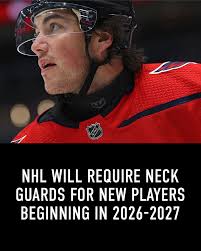BREAKING‼️ The NHL will require neck guards for all new players beginning in the 2026-27 season.
BREAKING‼️ NHL to Mandate Neck Guards for All New Players Starting in the 2026–27 Season
In a landmark move toward player safety, the National Hockey League (NHL) has announced that starting with the 2026–27 season, neck guards will be mandatory for all new players entering the league. The decision, revealed in a press release Monday morning, marks a significant shift in the league’s approach to injury prevention—particularly in light of recent high-profile incidents involving neck injuries.
A Long-Awaited Decision in the Name of Safety
The new rule will apply specifically to all rookies and newly signed players, regardless of age or experience in other professional leagues. While veteran players already in the league will not be immediately required to comply, the NHL has stated that it strongly recommends neck protection for all players and may expand the requirement in the future pending further evaluation.
The NHL’s Executive Vice President of Hockey Operations, Colin Campbell, described the move as “a proactive, research-driven policy aimed at reducing preventable injuries, particularly those that have proven to be life-threatening in rare but devastating cases.”
“This is about protecting the future of our game,” Campbell said. “Hockey will always be a fast and physical sport, but that doesn’t mean we should ignore clear advancements in protective equipment. We’ve seen too many close calls, and in some cases, true tragedies. This is the right step.”
Tragedies Spark Action
The policy comes in the wake of a global hockey community still reeling from the tragic death of Adam Johnson, a former NHL player who passed away in late 2023 after suffering a fatal neck laceration during a game in England. The incident sent shockwaves across the sport, renewing debate about the need for mandatory neck protection.
In the months that followed, several leagues—including the English Ice Hockey Association (EIHA) and various junior and European organizations—moved swiftly to make neck guards compulsory for all players at all levels. The NHL, long seen as hesitant to mandate such equipment for its elite athletes, has now responded with a carefully phased policy designed to protect new players without facing immediate union pushback.
Mixed Reactions from Players
Reaction among current NHL players has been mixed, as expected. Younger players and recent draft picks appear generally supportive of the measure, especially those who already wore neck protection at the junior or collegiate level. However, some veterans have expressed concern over comfort and mobility.
“I get why they’re doing it,” said veteran defenseman Erik Johnson. “But to be honest, for those of us who’ve played our whole lives without them, it’s going to take a lot to get used to. That said, you can’t argue with wanting to avoid a freak accident that could end someone’s life.”
Connor Bedard, one of the league’s brightest young stars and someone expected to still be active when the rule takes effect, praised the NHL’s leadership. “Hockey’s a fast game, and stuff happens. If there’s something that gives us a little more protection out there, I think most of us are on board.”
What the Rule Entails
Under the new policy, all new NHL players must wear cut-resistant neck protection that meets certified safety standards approved by both the NHL and the NHL Players’ Association (NHLPA). The exact specifications will be finalized following continued collaboration with equipment manufacturers and medical experts.
The league will also work with teams and trainers to ensure players are educated on how to properly wear and maintain their neck guards.
In a joint statement, the NHLPA expressed support for the policy, stating, “The safety of our players is paramount. This rule, implemented thoughtfully and based on real-world evidence, is a welcome change for the next generation of NHL athletes.”
A Cultural Shift
The NHL’s mandate reflects a broader culture shift across professional hockey. For decades, certain protective measures—such as visors or helmets—were seen as optional or even “unmanly” by some old-school players. Over time, however, evolving safety data, tragic incidents, and changes in player attitudes have helped normalize protective gear.
Helmets became mandatory in 1979 for all new players, with a similar “grandfather clause” for existing athletes. Visors followed in 2013. Now, the neck guard appears to be the next frontier.
Looking Ahead
The NHL’s announcement has been largely praised by fans, safety advocates, and medical professionals. As technology advances and the sport continues to grapple with its physical nature, such steps may become increasingly common.
Still, questions remain: Will veteran players eventually be required to adopt neck protection? Could the rule spark similar mandates across other North American pro leagues? What role will the NHL’s move play in youth and amateur hockey regulations?
Only time will tell, but one thing is certain—starting in 2026, the NHL will begin a new chapter where player safety extends from head to neck, setting a new standard for the world’s top hockey league.
—
#NHLNews #HockeySafety #NeckGuards #PlayerWelfare #2026RuleChange

